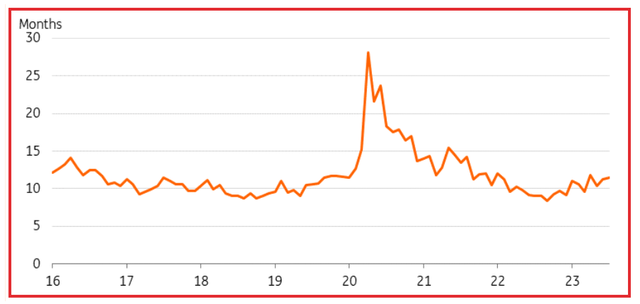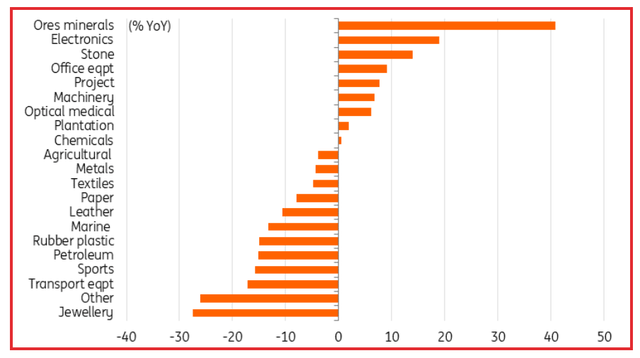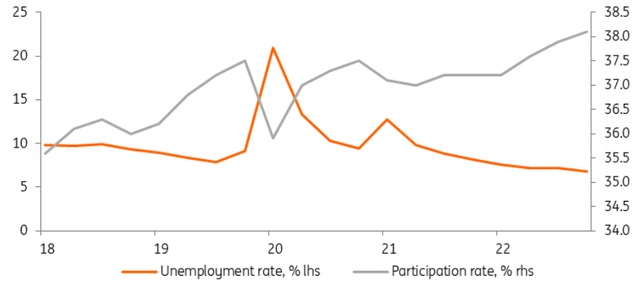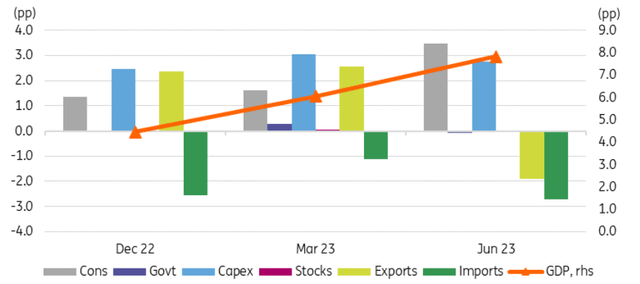India’s economy is on a solid growth trajectory, fueled by a multitude of critical factors. As the fastest-growing major economy in the world this year, India’s remarkable growth is driven by robust domestic demand and a steady influx of capital investment. A key initiative towards promoting growth and infrastructure development is the reduction of India’s budget deficit. Moreover, the Indian rupee has demonstrated remarkable stability and strength against the USD, outperforming other currencies in the Asia-Pacific region. The credit for this stability is attributed to the intervention of the Reserve Bank of India (RBI) and the presence of healthy foreign exchange reserves. Although India’s trade balance has been impacted by declining exports, particularly in the jewelry and agricultural sectors, the inclusion of Indian government bonds in global indices is expected to attract considerable foreign capital. Moreover, while inflation in India has risen, it is anticipated to decrease in the second half of the year, potentially leading to a reduction in policy rates in 2024. With this strong support from various factors, India’s economy is poised for continuing solid growth.
Increasing Domestic Demand
Growing middle class
India’s economic growth is driven largely by the growing middle class population. With a large percentage of the population moving out of poverty and into the middle class, there has been a significant increase in domestic demand for goods and services. This trend is expected to continue, further fueling economic growth in the country.
Rising disposable income
As the middle class in India grows, so does disposable income. This increase in disposable income has led to a surge in consumer spending, particularly on non-essential goods and services. The rising disposable income is a key factor in driving domestic demand and stimulating economic growth.
Infrastructure development
The Indian government has been undertaking significant infrastructure development projects across the country. These projects include the construction of roads, railways, airports, and ports, among others. The development of infrastructure has not only improved connectivity within the country but has also led to increased economic activity, job creation, and enhanced domestic demand.
Government initiatives
The Indian government has implemented various initiatives to boost domestic demand and support economic growth. These initiatives include the implementation of Goods and Services Tax (GST), the Pradhan Mantri Jan Dhan Yojana (financial inclusion program), Make in India campaign, and the Digital India program, among others. These initiatives have played a crucial role in increasing domestic demand and fostering economic growth in the country.
Capital Investment
Foreign direct investment (FDI)
India has been attracting significant foreign direct investment (FDI) in recent years. The government has undertaken various policy reforms and eased restrictions on FDI in several sectors, making India an attractive destination for foreign investors. The inflow of foreign capital has not only contributed to economic growth but has also led to job creation and technology transfer.
Investment in infrastructure
In addition to domestic investment, there has been a significant increase in investment in infrastructure projects in India. Both the government and private sector have been investing heavily in sectors such as roads, railways, airports, power, and telecommunications. This increased investment in infrastructure has not only improved the quality of life for citizens but has also created employment opportunities and boosted economic growth.
Technology sector growth
India has emerged as a global hub for the technology sector, with a thriving start-up ecosystem and a pool of skilled professionals. The growth of the technology sector has attracted significant capital investment, both domestic and foreign. This investment has not only contributed to economic growth but has also fostered innovation, job creation, and skill development in the country.

This image is property of static.seekingalpha.com.
Budget Deficit Reduction
Fiscal consolidation
The Indian government has been undertaking measures to reduce the budget deficit and achieve fiscal consolidation. These measures include rationalizing subsidies, improving tax compliance, and controlling government expenditure. The aim of fiscal consolidation is to create a favorable macroeconomic environment for sustained economic growth.
Promoting growth
While focusing on budget deficit reduction, the Indian government has also taken steps to promote growth in the economy. These steps include providing incentives for investment, promoting ease of doing business, and implementing structural reforms. The government’s efforts to balance fiscal consolidation with growth promotion are aimed at ensuring sustainable and inclusive economic development.
Infrastructure development
Investment in infrastructure development is a key component of the Indian government’s strategy to reduce the budget deficit. By improving infrastructure, the government aims to enhance productivity, attract investment, and stimulate economic growth. Investments in sectors such as roads, railways, airports, and digital infrastructure are expected to have a positive impact on the economy, leading to a reduction in the budget deficit over time.
Stable Indian Rupee
Reserve Bank of India intervention
The Reserve Bank of India (RBI) plays a crucial role in maintaining the stability of the Indian rupee. The RBI intervenes in the foreign exchange market to prevent excessive volatility in the rupee’s value. Through various instruments, such as open market operations and foreign exchange interventions, the RBI ensures that the rupee remains stable and strong against major currencies.
Healthy foreign exchange reserves
India’s foreign exchange reserves have been growing steadily over the years, reaching record levels. These reserves act as a cushion against external shocks and provide stability to the Indian rupee. The healthy foreign exchange reserves indicate the country’s ability to meet its international financial obligations and contribute to maintaining the stability of the Indian rupee.

This image is property of static.seekingalpha.com.
Trade Balance Impact
Decline in exports
India’s trade balance has been impacted by a decline in exports, particularly in sectors such as jewelry and agriculture. Factors such as global economic slowdown, trade tensions, and disruptions caused by the COVID-19 pandemic have contributed to the decline in exports. The decline in exports has put pressure on the trade balance, affecting the overall economic growth.
Jewelry and agricultural sectors affected
The decline in exports has been particularly pronounced in the jewelry and agricultural sectors in India. The jewelry sector, which is a major contributor to India’s exports, has been affected by weak global demand and volatility in gold prices. Similarly, the agricultural sector has faced challenges such as weak global prices and fluctuations in crop yields due to climate change. These challenges have impacted the trade balance and necessitate measures to boost exports from these sectors.
Attracting Foreign Capital
Inclusion of Indian government bonds in global indices
The inclusion of Indian government bonds in global indices, such as the JP Morgan Bond Indices and FTSE Russell’s Government Bond Index, is expected to attract substantial foreign capital. Inclusion in these indices increases the visibility and accessibility of Indian government bonds to global investors, making India an attractive investment destination. The influx of foreign capital is not only expected to support economic growth but also strengthen the country’s financial markets.
Substantial foreign capital expected
India has been witnessing a surge in foreign capital inflows in recent years. The government’s policy reforms and efforts to improve the ease of doing business have created a favorable investment climate. With the country’s growing middle class, rising domestic demand, and potential for high returns, India is expected to continue attracting substantial foreign capital across various sectors, further driving economic growth.

This image is property of static.seekingalpha.com.
Inflation and Policy Rates
Rise in inflation
Inflation in India has been on the rise in recent times. Factors such as higher fuel prices, supply chain disruptions, and increase in commodity prices have contributed to inflationary pressures. Although inflation poses challenges, it is also an indicator of increased economic activity and demand. The rise in inflation calls for appropriate policy measures to maintain price stability while supporting economic growth.
Expected decrease in the second half
Despite the rise in inflation, there are expectations of a decrease in the second half of the year. Factors such as easing of supply chain disruptions, improved agricultural production, and stabilization of global commodity prices are expected to ease inflationary pressures. This expected decrease in inflation is likely to have a positive impact on the economy, supporting consumption and investment.
Potential reduction in policy rates in 2024
Given the expectations of decreasing inflation, there is a possibility of a reduction in policy rates in the year 2024. Lower policy rates can stimulate economic activity by reducing borrowing costs for businesses and individuals. A potential reduction in policy rates in 2024 could further support economic growth, investment, and domestic demand.
Solid Growth Outlook
Continued solid growth
Despite the challenges posed by various factors, India’s economy is expected to continue growing solidly. The country’s strong domestic demand, robust investment climate, and focus on infrastructure development provide a solid foundation for sustained economic growth. Moreover, the growing middle class, rising disposable income, and favorable demographic profile further contribute to the positive growth outlook.
Support from various factors
India’s growth outlook is supported by various factors. The government’s initiatives to boost domestic demand, attract foreign capital, and promote growth provide a conducive environment for economic expansion. Additionally, the stability of the Indian rupee, healthy foreign exchange reserves, and expected decrease in inflation are expected to further enhance the growth prospects. With a strong growth trajectory, India is poised to continue its journey as the fastest-growing major economy in the world.

This image is property of static.seekingalpha.com.
